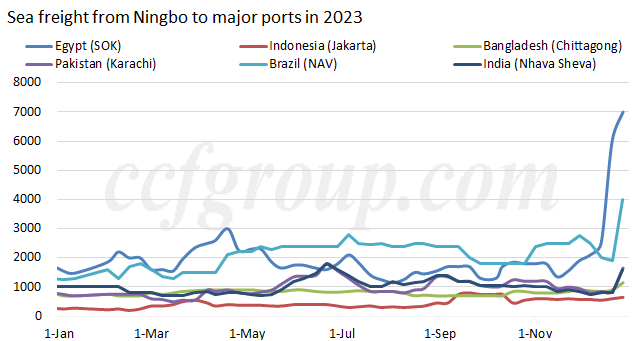The impact of global marine market disturbance on China's textile and apparel export
As a route carrying 12% of the world's trade and transportation, the situation in the Red Sea region affects the entire shipping industry. In order to avoid safety risks, more and more ships began to detour, and the detour also further led to soaring freight rates. In addition, since December, the volume of traffic through the Panama Canal has continued to decrease. The two major shipping "throats" are blocked at the same time, making the shipping market full of variables and putting the global supply chain in crisis.
Under the background that the tension in the Red Sea has not been obviously eased, the spot freight rate hiked and many bullish news appeared on the market. The EC futures has risen significantly.
The problem of safe passage in the Red Sea region continues to disturb the global shipping market. The short-term shipping capacity of marine market remains tight, and the spot freight rate increases significantly. At present, the routes exported from Shanghai Port to Europe, the Mediterranean Sea and the Persian Gulf near the Red Sea are most affected. As of December 22, the freight rates on the three routes were up 45.5%, 30.9% and 25.7%, respectively, from the previous week.
85% of container liner companies have suspended cargo on the Red Sea route, according to a report released on December 22 by the Ningbo Shipping Exchange. Affected by this, it was hard to book shipping space on some routes and the spot booking price hiked. Ningbo Shipping Exchange released the Red Sea route index also rose 161.9% to 3649.5 points compared with the previous week. For example, the freight from Ningbo to Egypt (SOK) soared to about USD 7000/40HQ, and most freight forwarders have not accepted orders in this direction.
At present, the blocked Red Sea route is likely to continue, detour to the Cape of Good Hope is the first choice for many shipping companies. Maersk revealed on December 22 that it has adjusted every voyage on its Asia-Europe and Middle East-Europe routes to pass through the Cape of Good Hope until mid-February.
In addition, the freight of other routes has increased to varying degrees, such as to Pakistan (Karachi) to rise to about US$1650/40HQ, to Indonesia (Jakarta) to hike to about US$650/40HQ and to Bangladesh (Chattogram) to spike to about US$ 1150/40HQ. Remark: the freight of different ships and forwarders differs, and the above freight is only for reference.

So what is the impact of the disturbance of the global shipping market on China's textile and apparel exports?
Europe and the Middle East are major textile and apparel export regions. Among which, EU-27 countries accounted for 13% of textile and apparel exports. In addition, North Africa is also the main export destination of polyester products. In 2022, the export of polyester products from China to North Africa was around 630kt, taking up about 6.8% of China's total polyester export. In terms of products, PET bottle chip and PFY accounted for 49% and 46% respectively. As the situation in the Red Sea escalates, Chinese shipping to North Africa has basically stagnated.
In general, the recent disturbance of the Red Sea situation to the global shipping market and the sharp rise in sea freight have created short-term negative effects on exports. First of all, most of the shipping from China to North Africa has been stagnant, resulting in difficulties in receiving orders and delivering, affecting the export of polyester products. Secondly, the exports of textiles and apparels to Europe, the Middle East and other places are also impacted, because some powerful foreign trade companies mostly adopt CIF mode for orders, so the recent surging sea freight on these regional routes on the one hand makes foreign trade enterprises lose profits, on the other hand, also delays delivery. In addition, the later placement of new orders may also be dragged down by this, mainly due to difficulties in price negotiation and the risk of uncertainty in delivery. On the other hand, rising price favors the destocking outside China. In long run, if the disturbance of shipping market reduces in the future, the placement of export orders is likely to accelerate warming.
- Top keywords
- Cotton Price
- Cotton Futures Price
- Cotton Futures
- CZCE
- PTA Futures Price
- Chemical Fiber
- Polyester Prices
- Wool price
- PTA Futures
- Shengze Silk
- China
- Yarn Price
- price
- China Textile City
- Fibre Price
- Benzene Price
- Cotton
- Index
- Cotton Index
- PTA
- fabric price
- NYMEX
- Top 10
- textile industry
- Spot Cotton
- Cotton Yarn
- Polyester Price
- Futures
- PTA Price
- cotton yarn price

